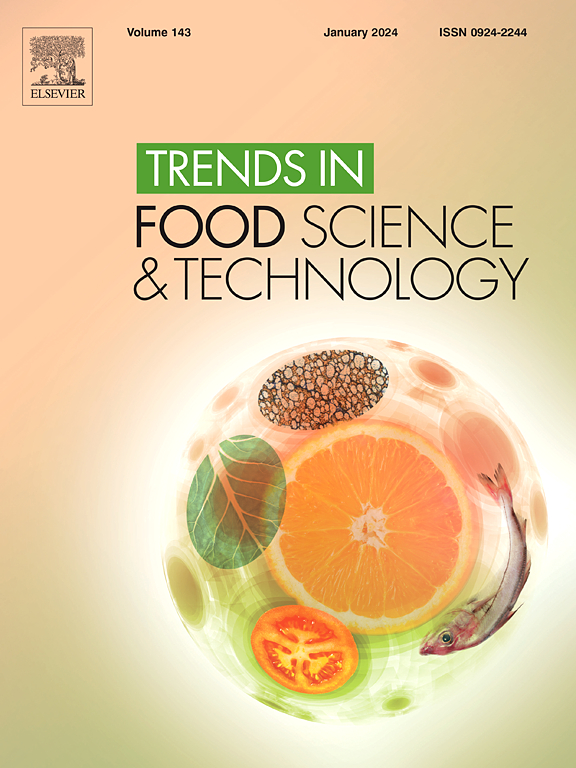Recent advances on peach aroma: Key aroma-active compounds and their metabolic pathways, analysis strategies, and innovative processing tools
IF 15.1
1区 农林科学
Q1 FOOD SCIENCE & TECHNOLOGY
引用次数: 0
Abstract
Background
Fresh peaches have been favored by consumers due to their juicy taste and attractive aroma. The changes in aroma-active compounds cause the differences in peach aroma from different stages, further affecting the aroma quality. Aroma loss or deterioration is usually happened during ripening and processing, hence, more and more attention has been paid to preserving the original aroma of peaches.
Scope and approach
Combing identification techniques with omics techniques, aroma-active compounds in peaches were effectively identified, and their changing mechanism were explained. Key factors affecting aroma release and innovative analytical techniques for aroma analysis were further summarized to provide a comprehensive understanding of peach aroma.
Key findings and conclusions
γ-Decalactone, hexanal, benzaldehyde, (E)-2-hexenal, β-ionone, linalool, and 1-hexanol contributed to the overall aroma of peaches mainly through the metabolisms of fatty acids, sugars, and amino acids, and the biosynthesis of phenylpropanoids/benzenoids and terpenoids, respectively. They were regulated by transcription factors, affecting the expression of lipoxygenase, alcohol dehydrogenase, alcohol acyl transferase, and chorismate synthase, carotenoid cleaving dioxygenase, and terpene synthases, revealing the formation mechanism of aroma-active compounds. Additionally, machine learning, molecular docking and neuroimaging techniques are promising innovative technologies for peach aroma analysis. Future research should focus on improving the aroma quality of peaches by regulating the expression of genes involved in the formation of aroma-active components, thereby preserving the original aroma of peaches. This review could provide a reference for the peach industry to improve or maintain the characteristic aroma of peaches during cultivation and processing.

桃香气研究进展:主要香气活性化合物及其代谢途径、分析策略和创新加工工具
新鲜的桃子因其多汁的口感和诱人的香气而受到消费者的青睐。香气活性物质的变化导致桃不同阶段香气的差异,进而影响其香气品质。桃子在成熟和加工过程中往往会发生香气的损失或变质,因此如何保持桃子原有的香气越来越受到人们的重视。范围与方法将鉴定技术与组学技术相结合,对桃中香气活性物质进行了有效鉴定,并对其变化机制进行了解释。进一步总结了影响桃树香气释放的关键因素和香气分析的创新技术,以期对桃树香气有一个全面的认识。γ-癸内酯、己醛、苯甲醛、(E)-2-己烯醛、β-离子酮、芳樟醇和1-己醇主要通过脂肪酸、糖和氨基酸的代谢以及苯丙素/苯类和萜类的生物合成对桃子的整体香气有贡献。它们受到转录因子的调控,影响脂氧合酶、醇脱氢酶、醇酰基转移酶以及choris酸合成酶、类胡萝卜素裂解双加氧酶和萜烯合成酶的表达,揭示了芳香活性化合物的形成机制。此外,机器学习、分子对接和神经成像技术是桃子香气分析的创新技术。今后的研究应着眼于通过调控芳香活性成分形成相关基因的表达来改善桃子的香气品质,从而保持桃子原有的香气。研究结果可为桃产业在栽培和加工过程中提高或保持桃的特征香气提供参考。
本文章由计算机程序翻译,如有差异,请以英文原文为准。
求助全文
约1分钟内获得全文
求助全文
来源期刊

Trends in Food Science & Technology
工程技术-食品科技
CiteScore
32.50
自引率
2.60%
发文量
322
审稿时长
37 days
期刊介绍:
Trends in Food Science & Technology is a prestigious international journal that specializes in peer-reviewed articles covering the latest advancements in technology, food science, and human nutrition. It serves as a bridge between specialized primary journals and general trade magazines, providing readable and scientifically rigorous reviews and commentaries on current research developments and their potential applications in the food industry.
Unlike traditional journals, Trends in Food Science & Technology does not publish original research papers. Instead, it focuses on critical and comprehensive reviews to offer valuable insights for professionals in the field. By bringing together cutting-edge research and industry applications, this journal plays a vital role in disseminating knowledge and facilitating advancements in the food science and technology sector.
 求助内容:
求助内容: 应助结果提醒方式:
应助结果提醒方式:


